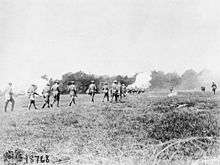326th Infantry Regiment (United States)
| 326th Regiment 326th Infantry Regiment 326th Glider Infantry Regiment | |
|---|---|
|
Distinctive unit insignia of the 326th Glider Infantry Regiment, World War II. | |
| Active |
1917–1919 1942–1946 |
| Country |
|
| Branch |
|
| Type |
Infantry Glider infantry |
| Size | Regiment |
| Garrison/HQ | Alliance Army Airfield |
| Motto(s) | Aspera Juvant, "Difficult Delight" |
| Colors | Blue, Gold, and White |
| Engagements |
World War I World War II |
The 326th Infantry Regiment was an infantry regiment of the United States Army that saw active service during World War I, as part of the 82nd Division and fought in the Meuse-Argonne Offensive and was inactivated in 1919. The regiment was reactivated during the interwar period and during World War II was converted into a glider infantry formation, becoming the 326th Glider Infantry Regiment, later transferring to the 13th Airborne Division but were not involved in any fighting.
History
Formation
Commanded by Colonel John C McArthur, the 326th Regiment was officially activated as part of the 82nd Division on 29 August 1917 at Camp Gordon, near Atlanta, Georgia. Being a National Army division, the regiment was composed of draftees. The only personnel actually assigned to the regiment however, were a small cadre charged with the task of preparing for the thousands of draftees who would soon be flooding the camp. The 326th Regiment and its sister regiment, the 325th, were members of the 82nd Division that was composed of officers and soldiers from what most would consider the "Deep South". This changed a few weeks into the training program. The War Department issued orders instructing the division to send all of its soldiers, minus a 783-man training cadre to other camps. Leaders watched as their soldiers departed to be replaced by soldiers from all regions of the United States. It was noted that the 82nd Division was now made up of soldiers from every state in the union. It is from this fact that the 82nd Division received its nickname "The All American Division" and is represented by the "Double A" patch worn today.
World War I
In April 1918, the 326th Infantry received orders to move to Camp Upton, New York in preparation for embarkation to France. Their short stay at Camp Upton reflected a growing crisis for the Allies on the Western Front. The German Army's Spring Offensive, launched in late March, was a desperate attempt to win the war then and there. The Germans had made gains of over 45 miles in France. Other attacks along the Somme, Lys, and Aisne Rivers had stretched the British and French to their absolute limits.
Upon their arrival in Le Havre, France, on May 17, the 326th began sending small detachments into the lines to accustom the men to trench warfare. On June 9, 1918, Captain Jewett Williams of the 326th was killed–the regiment's first casualty.

The regiment's first combat assignment was to relieve the 101st Infantry of the 26th Division in the Toul sector in France where they would enter the line as part of the 82nd Division under the control of the French Seventh Army. On August 4, the regiment engaged in the 82nd Division's first offensive action. The 326th went "over the top", advancing behind an artillery barrage to capture 3 German machine guns, inflict 73 casualties, and secure the information needed by headquarters. Shortly after this action the 326th was relieved and moved to form part of the Marbache defense sector.
The 326th had its first encounter with the deadly mustard gas used by the Germans on September 12. They endured a night-long barrage of explosive and chemical artillery and persistent strafing by German aircraft. When the sun rose the next morning the soldiers looked out onto a contaminated wasteland. Although the attack on Saint-Mihiel was unsuccessful, the 326th Infantry Regiment held its ground and accomplished its mission.
The Meuse-Argonne Offensive was the last major offensive of the war. It was designed to penetrate the German lines and disrupt their logistical base. This was preparatory to further offensive operations involving the actual invasion of Germany.
Through ten days of battle, the regiment was able to punch a hole in the German's last line of defense. With their removal, Allied forces had a clear shot at continuing to advance into Germany. The regiment, as an integral part of the 82nd Division, shared the distinction of serving in active operations longer, and without relief, than any other regiment in the American Expeditionary Force (AEF) on the Western Front.
The 326th remained in France, in the Prauthoy area, after the Armistice of November 11, 1918 was signed. It returned to the United States in April, 1919, and was demobilized at Camp Mills, New York. It was reconstituted as an Organized Reserve Unit after the war and allotted to the IV Corps Area until the outbreak of World War II.
World War II
When World War II began, the regiment became designated as the 326th Glider Infantry Regiment to be assigned to the 82nd Airborne Division. However, in 1943, the regiment was detached form the division and was sent to US to train at Alliance, Nebraska. It was reassigned to the 13th Airborne Division and sent to Europe, but didn't see any combat action. When the war ended, the regiment was deactivated at Camp Kilmer, New Jersey.
References
- http://www.ww2-airborne.us/units/326g/326g.html
 This article incorporates text from this source, which is in the public domain.
This article incorporates text from this source, which is in the public domain. - Ruge, Edwin. The History of Company M, 326th Infantry, 82nd Division, American Expeditionary Forces. [New York]: [publisher not identified], 1932. OCLC 317730904